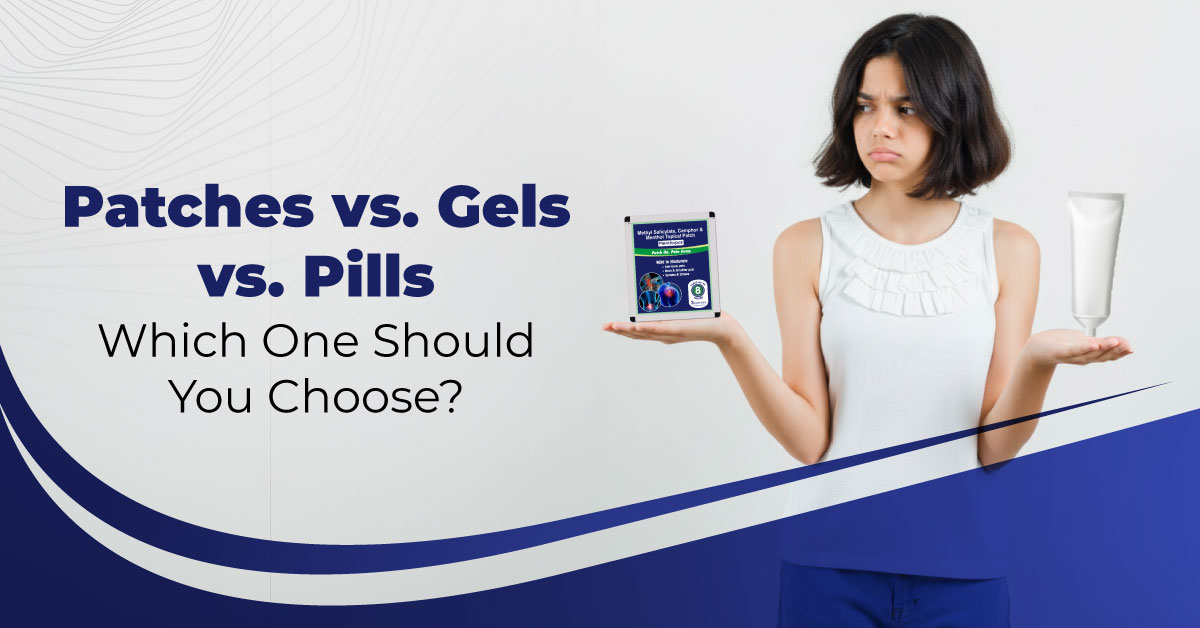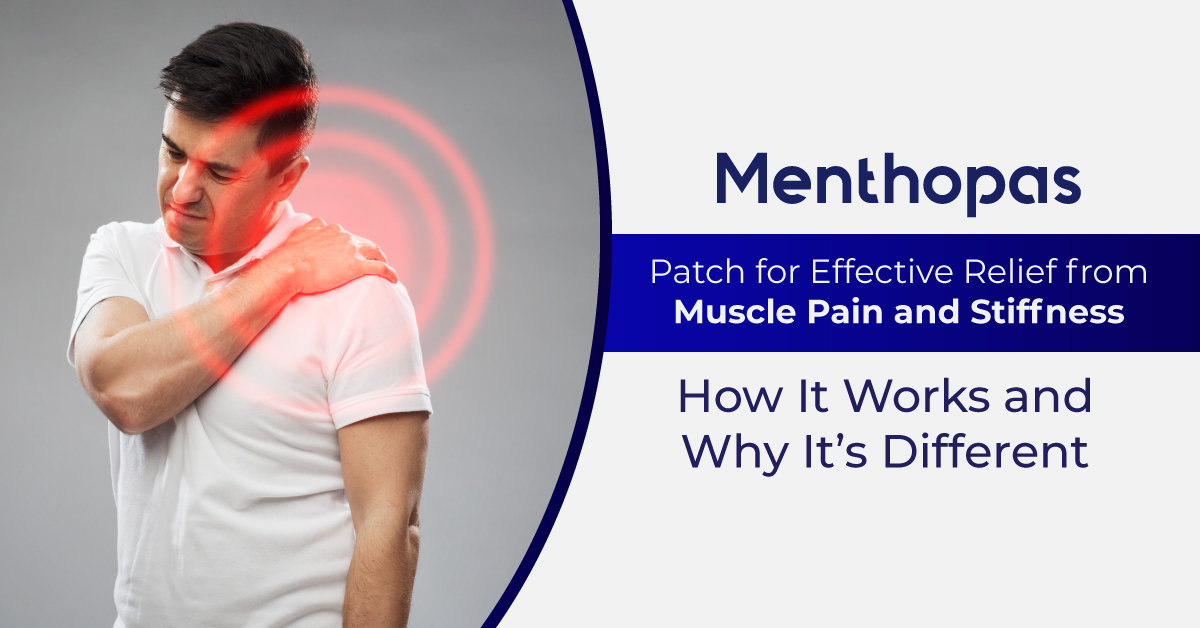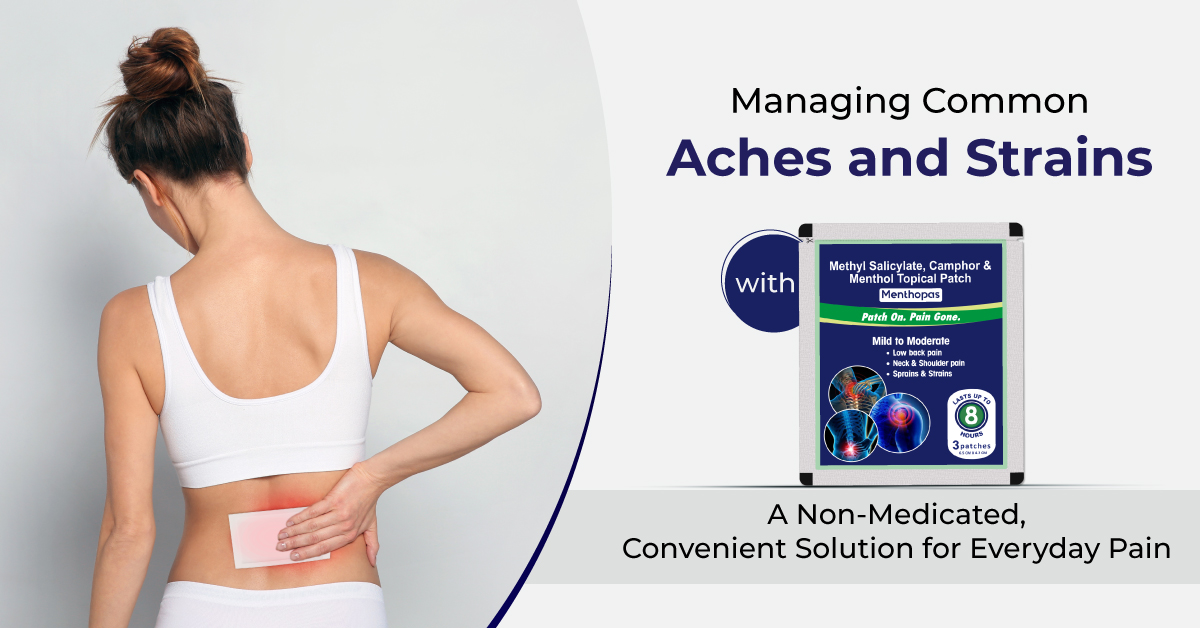 12-Nov-2025
12-Nov-2025
Patches vs. Gels vs. Pills – Which One Should You Choose?
Introduction
When pain strikes — whether it's stiff shoulders from long desk hours, backache after travel, or sore muscles post-workout — most people reach for the quickest option at hand. For some, that's swallowing a pill. For others, it's rubbing on a gel or balm. But there's now a third option: pain relief patches. Each method has its pros and cons, and choosing the right one depends on the type of pain, your lifestyle, and how fast you need relief.
In this blog, we'll compare patches, gels, and pills across speed, convenience, safety, and long-term suitability. By the end, you'll see why patches like Menthopas are increasingly becoming the smarter choice.
Pills: The Traditional Quick Fix
Pills are the most common form of pain relief. Whether it's over-the-counter paracetamol, ibuprofen, or prescription medications, they work systemically — entering the bloodstream and affecting the whole body.
Pros
- Easy availability — most households already stock them.
- Fast action for widespread or severe pain.
- Clinically studied and trusted.
Cons
- It can irritate the stomach and intestines, especially with frequent use.
- Potential strain on the liver or kidneys over time.
- Not suitable for everyone (pregnant women, people with ulcers, or those on certain medications).
- Often overused without addressing root causes.
Pills are best for general or severe pain that isn't localised — such as headaches, fevers, or systemic inflammation. But for local muscle or joint pain, they may be stronger than needed.
Gels & Creams: The Topical Tradition
Pain-relief gels and creams are widely used for localised aches. They're applied directly to the skin over painful areas and often contain menthol, camphor, or NSAIDs (non-steroidal anti-inflammatory drugs).
Pros
- Targeted to a specific area.
- Cooling sensation provides quick comfort.
- Easy to buy and apply.
Cons
- Messy and greasy — can stain clothes or bedsheets.
- Odour is noticeable — some balms announce their presence in the room.
- Short-lived relief; may require frequent reapplication.
- Not discreet in professional or social settings.
Gels are best for occasional use at home, especially when you don't mind the smell or mess. But for people on the move, they're less practical.
Patches: The Modern Alternative
Pain relief patches use transdermal delivery technology — active ingredients pass through the skin layers into the targeted tissue below. Unlike gels, patches provide steady, sustained relief for hours.
Pros
- Targeted action — relief exactly where it's needed.
- Long-lasting (many patches provide 6–12 hours of relief).
- No mess, no smell, no stains.
- Discreet — can be worn under clothing while you go about your day.
- Portable — slim and travel-friendly.
Cons
- Take a few minutes longer to "kick in" compared to pills.
- Should not be used on broken or irritated skin.
- Limited coverage area (not for widespread body pain).
Patches shine in localised muscle or joint pain — backaches, shoulder stiffness, knee pain, menstrual cramps, and post-workout soreness. They blend into everyday life without interruption.
Side-by-Side Comparison
| Factor | Pills | Gels/Creams | Patches |
|---|---|---|---|
| Speed of Relief | Fast, systemic | Fast, local cooling | Steady, builds over minutes |
| Duration | 4–6 hrs | 1–2 hrs | 6–12 hrs |
| Convenience | Requires water | Messy to apply | Discreet, portable |
| Safety | Possible side effects on organs | Skin irritation, smell | Safe, non-invasive |
| Best For | General/systemic pain | At-home local pain | Local pain, on-the-go relief |
Why Menthopas Stands Out
Among patches, Menthopas Pain Relief Patch is designed with modern needs in mind:
- Targeted: Works exactly on the pain point.
- Fast-acting: Menthol and camphor provide cooling and soothing as soon as the patch adheres.
- Convenient: No pills, no greasy hands, no interruptions.
- Long-lasting: Relief for hours, even during work, travel, or sleep.
- Discreet: No strong smell, no visible mess, fits seamlessly into daily life.
For professionals in meetings, travellers on flights, homemakers with repetitive chores, or athletes after training, Menthopas fits into routines without drawing attention.
When to Use Each Option
- Choose pills for general body pain, fever-related aches, or severe flare-ups where systemic relief is needed.
- Choose gels when at home, and when you want an immediate cooling effect without worrying about stains or odour.
- Choose patches when you need discreet, long-lasting, on-the-go relief for localised pain.
Smart pain management isn't about "one or the other" — it's about picking the right tool for the right situation. But for daily life and localised discomfort, patches often offer the perfect balance.
Practical Tip
Think of patches as your "wearable pain relief." Keep a few in your office drawer, gym bag, or travel pouch for easy access. That way, relief is always within reach, without depending solely on pills or messy balms.
Wrapping Up
The world of pain relief has moved beyond the traditional pill-and-gel approach. Patches offer a modern, safe, and lifestyle-friendly alternative that delivers relief exactly where it's needed — without side effects or inconvenience.
With Menthopas, you get a solution that combines science with simplicity: just stick, soothe, and move on with your day.
Finally, let's get to know Menthopas itself in detail — ingredients, safety, and how it stands apart in real-world use. Stay tuned for our next blog.
Related Blogs

Menthopas Patch for Effective Relief from Muscle Pain and Stiffness: How It Works and Why It’s Different

